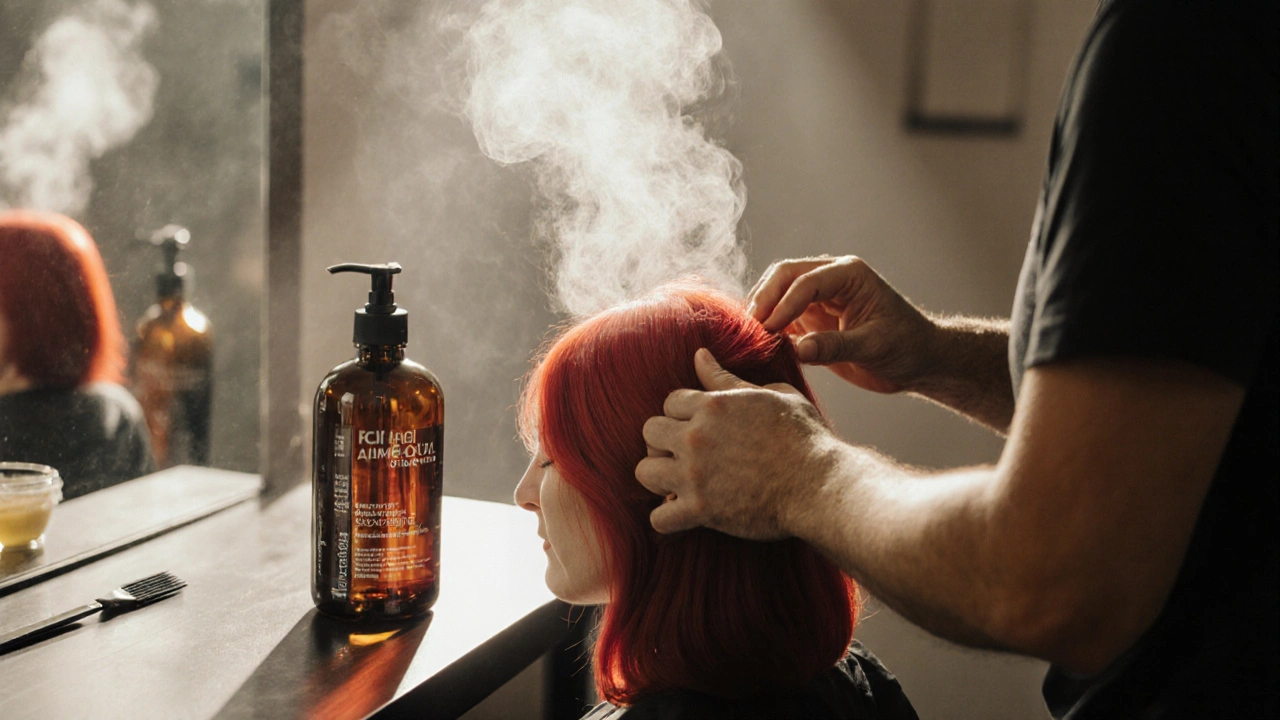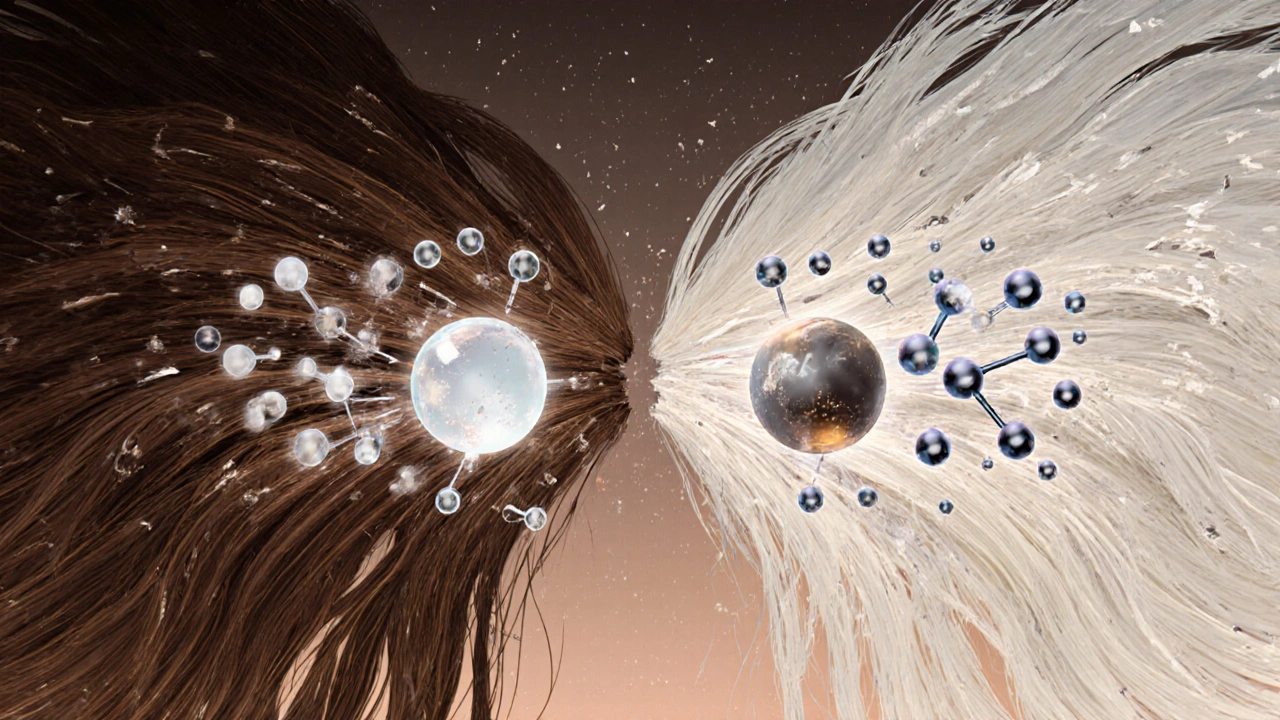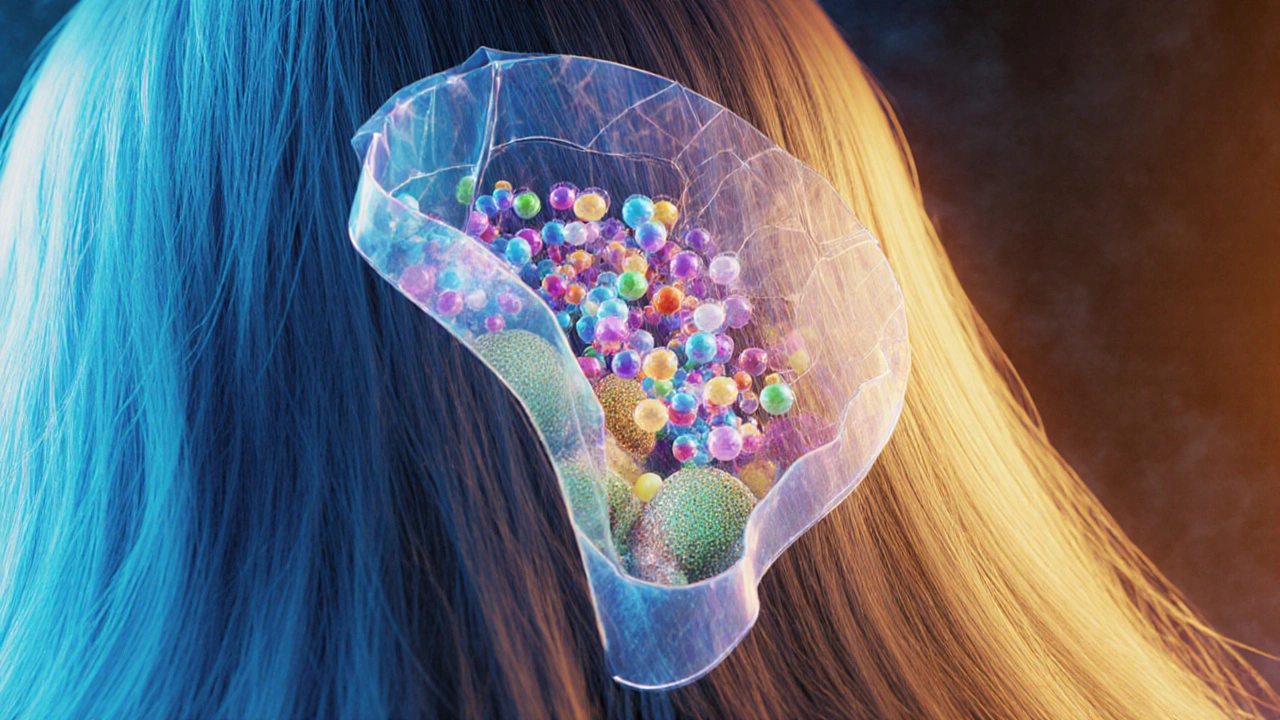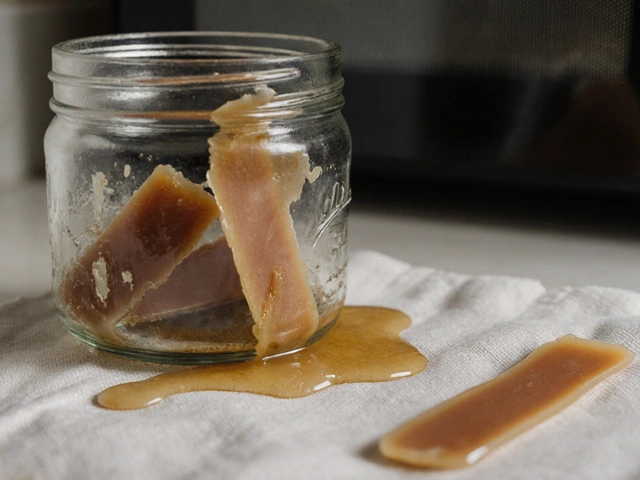Ever wondered why your hair dye smells so sharp when you open the box? That strong, stinging odor isn’t an accident - it’s the smell of ammonia, and it’s there for a very specific reason. Ammonia isn’t added to make your hair dye smell bad. It’s added because it works - better than almost anything else - at getting color deep into your hair. But here’s the catch: just because it works doesn’t mean it’s the best choice for everyone. Understanding why ammonia is used helps you make smarter decisions about what you put on your scalp and strands.
How Ammonia Opens the Door for Color
Your hair isn’t just a strand of protein. It’s a layered structure. The outer layer, called the cuticle, is made of overlapping scales that protect the inner cortex - where your natural pigment lives. For permanent hair dye to work, the color molecules need to get past that cuticle and into the cortex. But the cuticle doesn’t just open up on its own. It needs help.That’s where ammonia comes in. Ammonia is a powerful alkaline agent. When mixed with peroxide in hair dye, it raises the pH of your hair from its natural level of about 4.5 to around 9 or 10. This sudden shift in acidity causes the cuticle scales to swell and lift, like opening a door. Once that door is open, the small color molecules can slip inside. Inside the cortex, they react with peroxide to form larger, permanent pigment molecules that can’t wash out. Without ammonia, most permanent dyes wouldn’t penetrate deep enough to last more than a few shampoos.
This isn’t just theory. Studies from Wella Professional show that ammonia’s small molecular size - just 17 atomic mass units - lets it penetrate quickly and then evaporate during processing. That’s key. Unlike some alternatives, ammonia doesn’t stick around. It does its job and leaves, reducing the chance of long-term buildup.
Why Ammonia Outperforms Alternatives for Major Color Changes
If you’re going from dark brown to platinum blonde, or covering 100% gray hair, you need serious lifting power. That’s where ammonia still wins. Ammonia-based dyes can lift hair up to 4-5 levels in a single application. Most ammonia-free formulas struggle to lift more than 2 levels without compromising hair health.Why? Because the most common ammonia replacement - monoethanolamine (MEA) - doesn’t work the same way. MEA has a much larger molecular structure. While it can raise pH like ammonia, it doesn’t evaporate. It stays on your hair even after you rinse. Studies from Combed Education show MEA concentrations in ammonia-free dyes are often 6% to 10%, compared to 1.5%-3.5% in ammonia-based formulas. That’s a huge difference in volume.
And here’s the problem: leftover MEA can continue reacting with your hair after the dye is rinsed out. This leads to gradual darkening, dullness, and even structural damage over time. Some brands even recommend special shampoos containing ammonium hydroxide (which breaks down into ammonia) just to wash out the leftover MEA. That’s like using one chemical to undo the damage from another.
Professional colorists know this. For clients needing high lift or full gray coverage, ammonia remains the go-to. Wella’s research confirms: for permanent color with lift of three levels or more, ammonia protects hair structure better than MEA. It’s not about being harsher - it’s about being more precise and efficient.
The Trade-Off: Smell, Sensitivity, and Long-Term Damage
Let’s be honest - ammonia stinks. And it irritates. Many people report scalp itching, redness, or burning during or after application. Salon workers are especially at risk. Long-term exposure to ammonia vapors has been linked to sinus issues, throat irritation, and even lung inflammation. That’s why so many people seek ammonia-free options.But here’s the twist: some ammonia-free dyes aren’t necessarily safer. A 2012 Japanese dermatology study found that certain non-ammonia formulas - particularly those using MEA and peroxide - caused more oxidative stress on the scalp and hair than ammonia-based ones. That stress led to increased hair loss and skin rashes in some users. The study noted that MEA is chemically derived from ammonia, so calling it “ammonia-free” is misleading. You’re not avoiding the chemistry - you’re just swapping one alkaline agent for another.
And while ammonia can damage the hair cortex over time - weakening tensile strength and making hair brittle - the damage isn’t always worse than the alternatives. Dr. Zeel Gandhi from SkinKraft warns that ammonia can strip natural melanin, leading to premature graying. But if your hair is already damaged from heat, bleach, or chemical treatments, any strong alkaline agent - ammonia or MEA - will make it worse.

Who Should Use Ammonia-Free Hair Dye?
Ammonia-free dyes aren’t bad. They’re just different. They’re best for:- People with sensitive scalps who react to strong odors
- Those wanting subtle color changes - like root touch-ups or adding lowlights
- Users who want to avoid the ammonia smell during application
- People who don’t need to lighten their hair more than 1-2 levels
Brands like Garnier Olia and L’Oréal INOA have perfected ammonia-free formulas that deliver decent gray coverage and shine without the fumes. They use oils, botanical extracts, and lower concentrations of MEA to condition while coloring. The trade-off? Less longevity and less lift. If you’re trying to go from dark to light, you’ll likely need multiple sessions - and more damage in the long run.
What About Semi-Permanent and Demi-Permanent Dyes?
If you’re not looking for permanent color, you don’t need ammonia at all. Semi-permanent and demi-permanent dyes don’t rely on lifting the cuticle as aggressively. They deposit color on the surface or slightly inside the cuticle without altering the natural pigment. These formulas often use milder alkalizers like ethanolamine or just rely on the natural porosity of your hair. They fade after 4-12 washes, which is perfect if you want to experiment without commitment.Wella, for example, only uses MEA in its demi-permanent lines - where no significant lightening is needed. That’s smart chemistry. You get color without the harshness, because you don’t need the power.

What’s the Best Choice for You?
There’s no universal answer. Your choice depends on what you’re trying to achieve.If you want:
- Full gray coverage + dramatic lightening → Choose ammonia-based dye. It’s the most reliable.
- Subtle color change + sensitive scalp → Go ammonia-free. Look for oil-infused formulas.
- Temporary color or gloss → Skip both. Use semi-permanent or color-depositing conditioners.
Also consider your hair’s current state. If it’s already dry, brittle, or chemically treated, even ammonia-free dyes can be too harsh. Always do a strand test before applying anything new. And never leave dye on longer than recommended - whether it has ammonia or not. Overprocessing is the real enemy.
What’s Next for Hair Color?
The industry is working on new alkalizing agents that don’t smell, don’t irritate, and still lift effectively. Some brands are experimenting with plant-based alkalizers, amino acid blends, and encapsulated delivery systems. But so far, nothing matches ammonia’s speed, efficiency, and evaporation rate.For now, the truth is simple: ammonia works better for major color changes. But it’s not the only option - and it’s not always the safest. The future of hair dye isn’t about eliminating ammonia entirely. It’s about matching the right chemistry to the right hair goal.
Is ammonia in hair dye toxic?
In the small amounts used in hair dye (1.5%-3.5%), ammonia is not considered toxic. It evaporates during processing and doesn’t remain in the hair. The real concern is irritation to the scalp, eyes, and respiratory system - especially with repeated exposure. People with asthma or chemical sensitivities should avoid it. The Japanese study cited by EcoColors found that some ammonia-free alternatives caused more oxidative stress than ammonia-based dyes, suggesting the risks aren’t always lower without ammonia.
Does ammonia-free hair dye cover gray hair as well?
It depends. Ammonia-free dyes can cover up to 70% of gray hair effectively, especially with newer oil-based formulas like Garnier Olia. But for full, stubborn gray coverage - especially in coarse or resistant hair - ammonia-based dyes perform better. If you have more than 50% gray and want a natural-looking, long-lasting result, ammonia is still the most reliable option.
Why does my hair feel dry after using ammonia-based dye?
Ammonia opens the hair cuticle, which allows dye to penetrate - but it also strips natural oils and proteins. This can leave hair feeling porous and dry. The damage isn’t always from ammonia itself, but from the combination of high pH and peroxide. Using a deep conditioner after dyeing and avoiding heat styling for a few days helps restore moisture. Look for dyes with built-in conditioners, like those with argan or avocado oil.
Can I switch from ammonia to ammonia-free hair dye?
Yes, but manage expectations. If you’ve been using ammonia-based dyes for dramatic color changes, switching to ammonia-free may mean less lift and less gray coverage. You might need to touch up roots more often. If you’re only doing subtle color shifts or maintaining your current shade, the switch is easy and often more comfortable. Always do a patch test first, even with ammonia-free products.
Are salon ammonia-free dyes better than at-home ones?
Not necessarily. The difference isn’t always in the formula - it’s in the application. Salon professionals know how to mix, time, and rinse color correctly. At-home users often leave dye on too long or skip conditioning steps, which leads to damage - whether the dye has ammonia or not. A professional-grade ammonia-free dye applied correctly can outperform a poorly used ammonia-based one.







Bharat Patel
November 20, 2025 AT 08:12It's funny how we blame ammonia for the smell but never think about what it's actually doing. It's not evil, it's just a tool. Like a hammer - ugly and loud, but gets the job done. We want perfect hair without paying the price, but nature doesn't work that way. Ammonia opens the door, and if you don't want to open doors, then don't expect to repaint the whole house.
Bhagyashri Zokarkar
November 20, 2025 AT 15:55i just dont get why ppl make such a big deal about ammonia like its some kind of poison lol i mean its just like when you cook with vinegar right? its strong but it goes away and you dont die? also my hair feels like straw after every dye but im not gonna stop coloring it cause i like being blonde even if i look like a confused potato
Rakesh Dorwal
November 22, 2025 AT 04:50Ammonia is a chemical weapon disguised as hair dye. The corporations know it's damaging but they don't care because they sell you the conditioner to fix what they broke. And don't get me started on MEA - that's just ammonia in disguise, renamed by lawyers so you'll keep buying. They're selling you poison and calling it 'gentle'. Wake up people. This isn't beauty - it's corporate control over your appearance.
Vishal Gaur
November 22, 2025 AT 23:54so like i read this whole thing and honestly i think the real problem is we dont know what we want. we want color that lasts forever but also dont want damage but also dont want to smell like a lab accident. its like wanting a sports car that gets 50mpg and never needs gas. ammonia does the job, mea tries to be nice but leaves residue, semi-permanent fades too fast. we just need to pick one and stop complaining. also my hair is still dry. sigh.
Nikhil Gavhane
November 23, 2025 AT 04:29There's something really human about this whole thing. We're trying to change how we look, but we're also scared of what we're putting on our bodies. It's not just about chemistry - it's about identity, control, and fear. Maybe the real question isn't whether ammonia is bad, but why we feel we need to change ourselves so badly in the first place.
Rajat Patil
November 23, 2025 AT 13:22I appreciate the detailed explanation. It is clear that ammonia has a role in the coloring process. However, I also understand that many individuals experience discomfort. The key is balance. One must consider both effectiveness and personal well-being. It is not a matter of right or wrong, but of suitability for each person.
deepak srinivasa
November 25, 2025 AT 03:25Wait, so if MEA doesn't evaporate and stays on the hair, why do companies claim it's safer? And if ammonia evaporates, why do people still get scalp burns? Is it the pH change or the actual residue? Also, what about the long-term effects on follicles over 10+ years? Anyone have data on that?
pk Pk
November 25, 2025 AT 16:43You're overthinking this. Hair dye isn't a science experiment - it's a tool. If you need to go from dark to light, use ammonia. If you just want to freshen up your roots, go ammonia-free. Simple. Stop listening to fear-mongers and brands pushing 'natural' as a premium. Your hair doesn't care about marketing. It cares about what works. And if you're worried, do a patch test. That's it.
NIKHIL TRIPATHI
November 27, 2025 AT 01:56Just wanted to add - I switched from ammonia to MEA after my scalp got really irritated. It worked fine for touch-ups, but when I tried to go lighter, it turned my hair orange and stayed that way for three weeks. Then I went back to ammonia and it lifted clean. The smell was awful, but at least it did what it was supposed to. Sometimes the 'bad' option is the only one that actually works.
Sandeepan Gupta
November 28, 2025 AT 07:43Good breakdown. One thing people miss: ammonia-free doesn't mean chemical-free. All dyes use alkaline agents. The real issue is how they're formulated with conditioners. A good ammonia dye with oils and proteins can be gentler than a cheap MEA dye with no care ingredients. Always check the full ingredient list, not just the 'ammonia-free' label. And always deep condition after. That's the secret.
Tarun nahata
November 28, 2025 AT 14:16Ammonia is the rockstar of hair dye - loud, obnoxious, and totally unforgettable. MEA is the shy backup singer who tries to be cool but keeps messing up the harmony. And semi-permanent? That's the indie band that plays one show and vanishes. We all want the rockstar... but we're too scared to buy the ticket. Reality check: if you want a transformation, you gotta pay the price. No free concerts here.
Aryan Jain
November 29, 2025 AT 00:32They're lying. Ammonia isn't just for dye - it's a tracking agent. The government and big beauty companies use it to monitor who's coloring their hair, how often, and what shade. That's why they push 'ammonia-free' as the safe option - it's a distraction. If you use MEA, your hair holds the chemical longer. That's how they track you. The smell? That's just the warning sign. Don't be fooled. Your hair is a data point now.